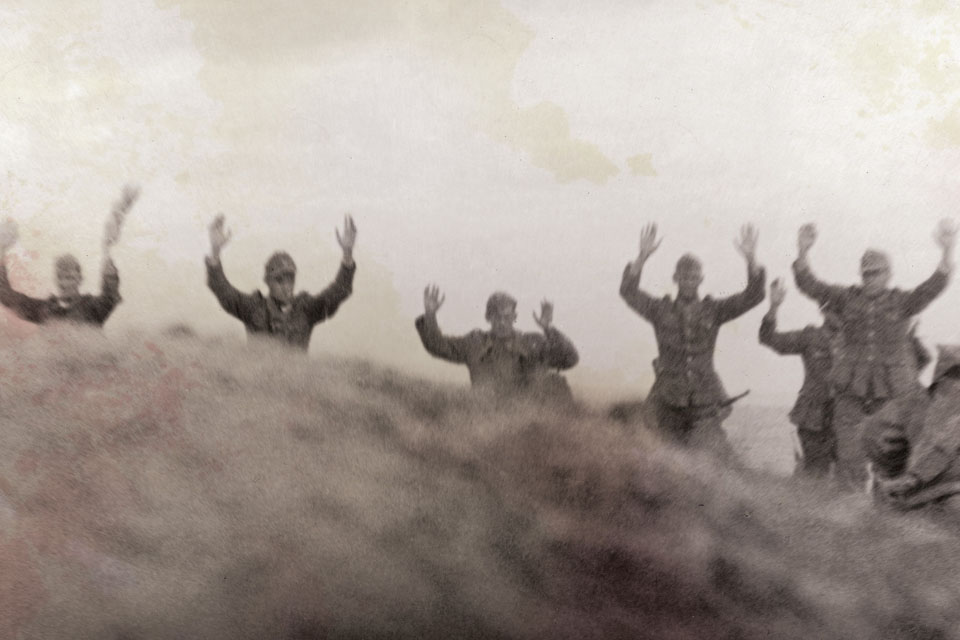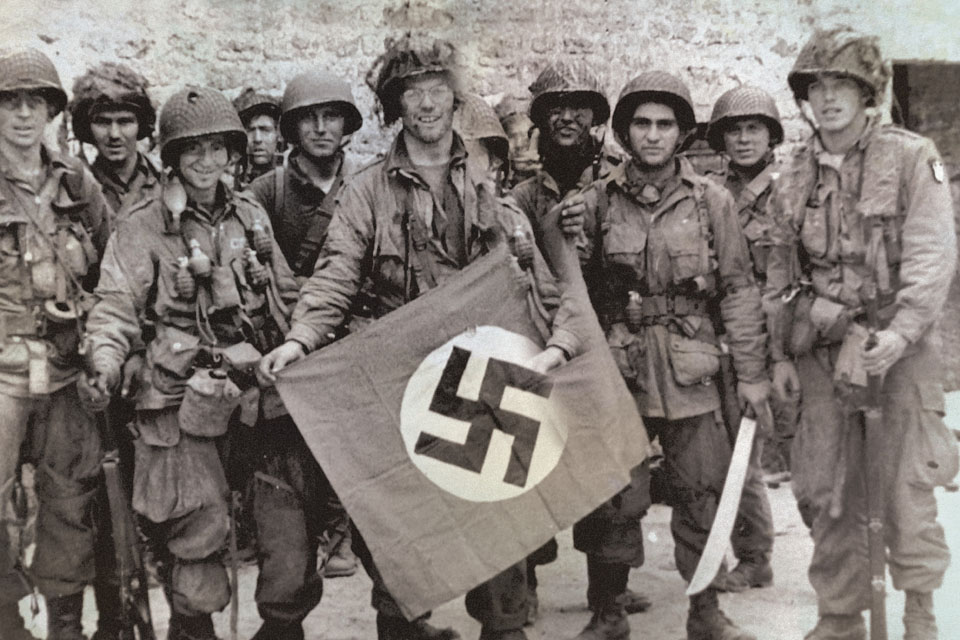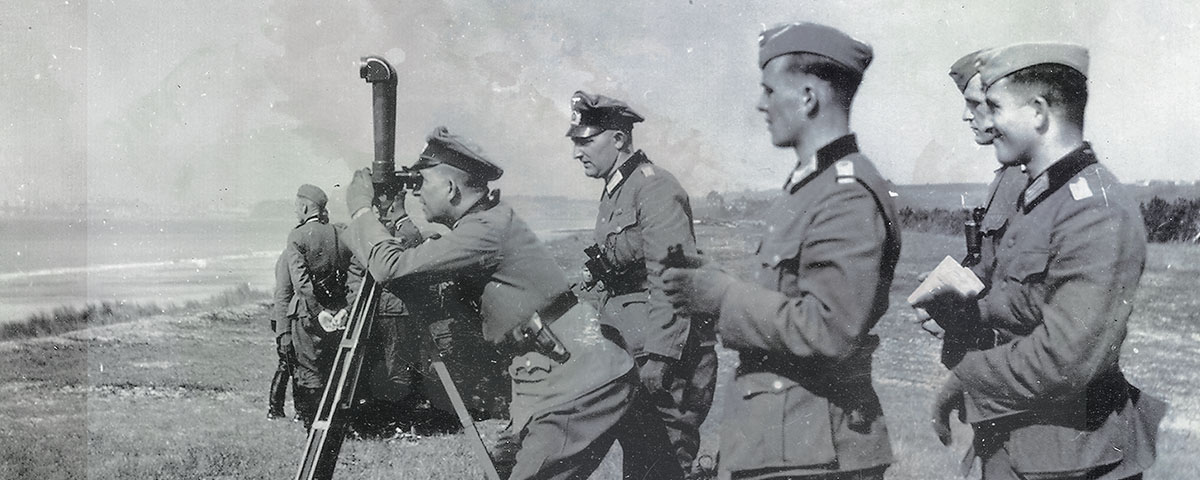As the Allies prepared for the Normandy Invasion, what was the enemy thinking?
We’ve all had the unhappy experience: the guests who wouldn’t leave. They show up unexpectedly and you scramble to respond, whipping together whatever food and drink you have on hand. Meanwhile, your surprise arrivals plop themselves down on the sofa, chatting away, eating your food, and drinking their way through your liquor cabinet like they own the place. The minutes become hours; day merges into night. They’re still there. You didn’t invite them in the first place, and now you’re not sure if they’re ever going to leave.
So it was for the German Wehrmacht in 1944. Germany’s armed forces had carved out a home for themselves in France: a position that its commanders insisted was impregnable, a great fortress of concrete and steel called the Atlantic Wall that would repel any Allied landing. They had spent years preparing for the invasion, doing everything that human ingenuity, military engineering, and slave labor could achieve. But when the visitors finally arrived, showing up suddenly one fine morning in the late spring of 1944, all those carefully laid plans fell apart.
On D-Day, June 6, 1944, the German hosts botched the reception. They failed to show their unwanted guests the door, and, in the end, the invaders moved in permanently.
The Germans seemed to be holding some high defensive cards as they prepared to fight the Allied invasion in 1944. Field Marshal Gerd von Rundstedt, the High Commander West (Oberbefehlshaber West, or OB-West), had Army Group B in northern France, under famed field marshal Erwin Rommel, and Army Group G in the south, commanded by General Johannes Blaskowitz. Each army group contained two constituent armies, for a total of four armies in all: Seventh and Fifteenth in the north, First and Nineteenth in the south. Take an average strength for a German army of about 225,000 soldiers, throw in independent units and support personnel, and call it an even million—enough to man 58 divisions.
As impressive as these numbers sound, Rundstedt had to spread them over 2,000 miles of European coastline. Many of his troops were so-called Eastern battalions (Ostbataillonen)—poor-quality units formed from former Soviet prisoners of war—and about half his divisions were “static,” lacking any form of trucks or transport. Plunked down on the beach, their mission was to resist the initial landing, fire at any force that happened to land in front of them, and then, presumably, die at their posts. Without transport, retreat wasn’t an option.
But what about the famous Atlantic Wall? An impressive project on paper, it was made of 17 million cubic yards of concrete and 1.3 million short tons of steel, enough of the former to build 270 Empire State Buildings and enough of the latter to construct the Eiffel Tower 160 times over. German propaganda delighted in showing images of immense gun emplacements, guarded by grim Aryan-looking soldiers straight out of central casting. In fact, though, German newsreels often showed the same shot again and again: the Lindemann Battery at Cap Gris Nez on the coast, with its three 406mm guns.
Elsewhere? Not so much. Rommel, taking command of the coastal defenses in late 1943, was appalled at the slipshod work he inspected. He did the job with his usual zeal, sowing millions of mines, building bunkers for the static divisions, and placing anti-boat obstacles at all the likely landing sites. His work was so good that the Allies had to change their plans to land at low tide instead of high tide. But in June even Rommel recognized that much needed to be done. Since the Allies had their choice of landing sites, the Germans needed to fortify every inch of beach in France. They never came close.
In truth, the task of defending France came down to a handful of panzer divisions. There were only 10 of them, and so their placement became the topic of a major tussle within the German High Command. Rommel knew how hard it was to operate under Allied air attack and wanted the panzers close to the water, where they could hit the Allies as they were slogging ashore. Rundstedt argued for a more orthodox posture, grouping the panzers into a strong, centrally located reserve, ready to smash the Allies as they advanced inland. The compromise reached in the end satisfied no one. The two army groups each got three panzer divisions to deploy as they wished; Panzer Group West, a central reserve under the command of General Leo Geyr von Schweppenburg, got the other four. The authority to send them into action, however, lay with the High Command of the Armed Forces (Oberkommando der Werhmacht, or OKW)—that is, with Adolf Hitler himself. With their limited resources, the Germans had tied themselves in knots.
The D-Day landings have become one of our great historical epics, filled with grand and glorious exploits of heroism. Seen from the German perspective, however, the romance vanishes, leaving the uninspiring spectacle of a once proud military force no longer up to the challenge. For years the Germans had been formulating plans for repelling an Allied landing in the west. But when it was time to act they found themselves aimlessly scrambling back and forth across Normandy, trying to put out whichever fire seemed most threatening.
The Allies came ashore at five invasion beaches along a 50-mile stretch of the Norman coast. Facing the landings—containing the spearheads of two complete Allied armies—was a single, understrength German corps, the LXXXIV, under General Erich Marcks. He had a mere three divisions, two of which were static. Unsurprisingly, all five landings succeeded. Three of them—Utah, Gold, and Sword Beaches—were easy, with minimal casualties. Another, the Canadian landing at Juno Beach, was difficult. And, of course, the fifth, the U.S. landing at Omaha Beach, nearly ended in disaster for the Americans.
On Omaha, a landing by the U.S. 1st and 29th Infantry Divisions had the misfortune of running into the one regular German infantry division in the invasion sector, the 352nd. The division’s 916th Grenadier Regiment, under Colonel Ernest Goth, held a naturally strong position, a semi-curved amphitheater with steep bluffs looming over the beach, and hulking concrete fortifications like Widerstandsnest 62, which stood about 100 yards from the water. From the moment the Americans hit the beach at 6:30 a.m., machine- gun fire erupted from the resistance nests. Mowing down the first wave, it shredded the dense mass of U.S. infantry desperately trying to find cover behind the tiny rocky ledge at the waterline, the “shingle.” Within 10 minutes, the beach was littered with dead and dying Americans. Lieutenant General Omar Bradley, floating offshore on the heavy cruiser USS Augusta, actually considered evacuating the beach.
But even with fate apparently handing them the U.S. Army on a platter, the Germans failed. Their soldiers spent the morning shooting, and they shot quite well, inflicting punishing casualties. But the Germans had no maneuver component, no counterattacking force, no tanks, no aircraft—nothing that could have driven a rattled U.S. landing force into the sea. The Germans had bunkers aplenty, but what they needed were more soldiers.

Things got no better for the Wehrmacht as the day wore on. The landing had come as a complete surprise, and many German commanders were away from their posts. Rommel was spending a day back at home, celebrating his wife’s birthday. Hitler, as was his wont, was sleeping in. General Friedrich Dollmann, the Seventh Army commander, had scheduled a planning war game in Rennes, testing responses to an Allied landing. His division commanders were on the road to Rennes, got the recall en route, and spent the morning scurrying back to their command posts. General Wilhelm Falley of the 91st Air-Landing Infantry Division could clearly hear the roar of thousands of Allied aircraft engines in the night sky. He turned his car around and raced back to his headquarters near Bernaville. As he pulled onto the grounds, however, Falley ran into a blaze of gunfire from U.S. paratroops of the 82nd Airborne Division. He became the first German general to die in Normandy.
With the commanders driving to and fro, the situation at the front descended into chaos. Consider the case of the 915th Regiment, under Colonel Ernest Meyer (and thus known as Kampfgruppe Meyer). Deployed inland in the Bayeux sector, the heart of the Normandy landings, Kampfgruppe Meyer was the sole reserve force for the LXXXIV Corps. Responding to reports just after midnight that Allied paratroops had landed south of the key crossroads town of Carentan, General Marcks ordered Meyer to clear up the problem. Meyer quickly assembled his grenadiers and was on the road by 3 a.m. But navigating Normandy’s narrow country lanes in the middle of the night was no easy task, and the battle group was still on the road at 6 a.m., when the sun came up and the vast Allied invasion fleet came into view off the coast. Soon Marcks’s corps was under attack everywhere: the 709th Division in the Cotentin, the 352nd Division between Vierville and Coleville-sur-Mer, and the 716th Division on the long stretch from Arromanches in the west to Ouistreham in the east.
Around 7 a.m., as Marcks was trying to process the threats, a new report came in: There had been no airborne drops south of Carentan, after all. It had been a mistake of some sort—a rumor, a jumpy patrol, a typo on the report. A reconnaissance flight could have clarified the situation in 10 minutes, but no German aircraft were in the sky. Marcks was operating in the unknown. The U.S. landing at Omaha had been smashed, that much seemed clear. On his right, however, the British had come ashore on a broad front, supported by tanks. They had penetrated the beach defenses of the 726th Regiment and were heading inland. With trouble clearly brewing on his right, Marcks ordered Meyer to turn around, head east at speed, and counterattack the British.
But even this simple job proved impossible. Meyer had to turn his units around and get them back into a march column. That process took an hour. Since Allied naval gunfire was ranging deep, the battle group had to loop south of Bayeux rather than head directly up the main road. Then the weather suddenly changed. As the skies cleared, they filled again with Allied fighter-bombers (jagdbomber; German soldiers called them jabos). Often thought of as killers, the fighter-bombers were in fact best at hampering German movement. The clock slipped past 11 a.m. and on to noon, and Meyer decided to postpone his counterattack until 2 p.m. That deadline, too, came and went. Much of the battle group was now strung out along the road, either pinned to the ground or taking cover from the rain of Allied bombs and strafing. By 3 p.m. it was too late. Elements of the British 50th Division now went over to the attack, Sherman tanks in the lead, jabos screaming overhead. The 50th easily overran the German assembly area, killing Colonel Meyer in the process, and soon the bulk of the regiment was in a hurried retreat to the west. Calling Kampfgruppe Meyer’s counterattack a failure isn’t quite accurate. It never even got started.
The Germans did manage one counterattack that day. On June 6 the 21st Panzer Division under Lieutenant General Edgar Feuchtinger was deployed 20 miles southeast of Caen (although the general, like so many others, was away from the front at the moment). Nevertheless, the men of the division reacted quickly to the Allied airdrops, fighting a series of sharp nighttime scraps with British paratroops who were dropping all around them. As dawn broke and the Allies landed on the beaches north of Caen, Marcks wanted the division to disengage and head for the beaches. The 21st Panzer was under Army Group B, however, so Marcks first had to get Rommel’s permission. But Rommel wasn’t there, either, and that meant a wearying series of radio messages with Colonel Hans Speidel, Rommel’s chief of staff.
Marcks finally got command of the 21st at noon. He immediately ordered it to cross the Orne River, wheel north through Caen, and drive to the sea. But as always for the Germans on June 6, slow motion was the order of the day. The division took three full hours to move the 10 miles from Ranville to (and through) Caen. Every man and vehicle had to squeeze over the few remaining undestroyed bridges in Caen, the sky was teeming with jabos the whole way, and losses in machines and men were heavy.
Not until 4:20 p.m. did it happen: a panzer attack on the Allied D-Day beachhead. The German battle array had the 22nd Panzer Regiment (Colonel Hermann Oppeln-Bronikowski) on the right, paired with elements of the 92nd Panzergrenadier Regiment (Colonel Joseph Rauch) on the left. Confidence was high. Oppeln was a skilled panzer commander with a reputation for hard drink and for dodging the reaper; his swagger and his luck were legendary with his men. Three times he had survived direct hits on his tank and walked away without a scratch.
The assault opened with Oppeln’s tanks rolling north toward Périers Ridge. His panzers were mainly Mark IVs, older models now upgraded with a high-velocity 75mm gun, though in most of the other relevant metrics—speed, armor, optics—the state of the art had long passed them by. Trundling along behind came the infantry on halftracks, along with self-propelled guns of various calibers mounted on the reliable French Lorraine 37L tracked chassis. The regiment moved out with gusto and was, as always, an impressive sight: the army that had invented mechanized, combined arms warfare once again on the prowl, apparently irresistible in the advance.
But appearances, as the saying goes, can be deceiving. Holding the ridge was a full British battalion, the Shropshire Light Infantry. Dug in, with well-hidden positions, it had a full complement of heavy weapons: 6-pounder antitank guns, Firefly tanks (a Sherman variant with a powerful, high-velocity 17-pounder gun), and self-propelled artillery. The Shropshires held their fire until the Germans came to the foot of the ridge and then opened up with the full spectrum. Six Mark IVs on the German right went up in flames in the opening minutes of the engagement, followed by nine more on the left near the village of Mathieu. Ten minutes later, the surviving German tanks were scrambling toward any gully, copse, or farmhouse they could find, desperately seeking cover. British fire had broken the momentum of the attack. Oppeln’s luck had run out.
The attack had greater success on the left, where the 1st Battalion of Rauch’s regiment managed to hit the seam between the British and Canadian landing forces. Forward they came against little enemy opposition or fire, their path eased by the attention being devoted to Oppeln’s abortive panzer attack to their right. In an hour they reached the sea at Lion-sur-Mer and Luc-sur-Mer, splitting the Allied beachhead, separating Juno Beach from Sword, and linking up with joyful elements of the 716th Static Division—still hanging tough in their bunkers on the coast—who had thought they were goners.
Rauch had reached the sea, traditionally a marker of victory. But to what end? He was now crammed in a tight spot between two powerful Allied forces pouring fire into his position from both flanks. A follow-up drive to the right or left was unthinkable, since it required a flank march along the shore, where any German assault column would have presented a perfectly silhouetted parade of targets. Allied naval commanders would have been licking their chops and adding up their kills.

The coup de grâce, fittingly, came from the air. At 9 p.m., with Rauch still holding his position at water’s edge and Feuchtinger still deciding what to do, a great force of aircraft passed overhead. The British were reinforcing their airborne bridgehead east of the Orne with an immense glider drop, some 250 craft, their tow planes, and dozens more fighters flying escort. Fearing an Allied airdrop into the rear of the division, Feuchtinger ordered Rauch to retreat and rejoin the main body of the 21st Panzer Division along Périers Ridge. Rauch’s regiment ended this day of drama slinking back to the south and, incidentally, leaving the remnants of the 716th Static Division to their unhappy fate after all.
June 6, 1944, was the “longest day,” all right—for the Germans. Indeed, it was a disaster. The bedrocks of the Wehrmacht’s defensive strategy in the West, the Atlantic Wall and the panzer divisions, were both abject failures. The Allies pierced the wall within the opening minutes of the landing, and only a single panzer division managed to head toward the beach and launch an attack.
Many factors fueled the catastrophe. Some historians blame German blundering (Hitler sleeping in, Rommel being out of reach) or the cleverness of the Allies in launching deception operations that fooled the Germans as to the time and place of the landings. And, of course, the popular imagination continues to focus on Allied heroism, especially those young American boys who landed under withering enemy fire and stormed the bluffs of Omaha.
While all these factors were important, the real reason for the Wehrmacht’s failure was much more basic: the sheer, raw power of its adversaries. The Allies had finally learned how to translate their wealth and industrial might into combat power at the front. Thousands of ships, tens of thousands of aircraft sorties, and the elements of nine divisions were in play on the Allied side that morning, while millions of men waited in the wings as a follow-on force. To resist this onslaught, the Wehrmacht fielded just three divisions—two low-grade static formations and a single infantry division—with no navy or air force. Whether Hitler slept in or not wasn’t going to change the balance of forces in Normandy.
As night fell on June 6, World War II had entered its final phase. Unexpected visitors had crossed the water with impunity, cracked the wall of Germany’s “Fortress Europe” at five places, and decided to stay. MHQ
Robert M. Citino is senior historian at the National World War II Museum in New Orleans and the author of eight books, including The German Way of War: From the Thirty Years’ War to the Third Reich; Death of the Wehrmacht: The German Campaigns of 1942; and The Wehrmacht Retreats: Fighting a Lost War, 1943.
Photo: Regional Council of Basse-Normandie/National Archives
[hr]
Featured in MHQ magazine’s Summer 2017 issue.
Want to have the lavishly illustrated, premium-quality print edition of MHQ delivered directly to you four times a year? Subscribe now at special savings!






